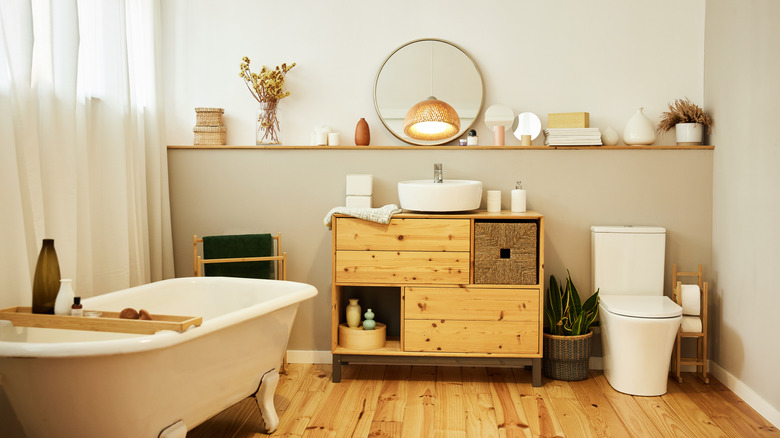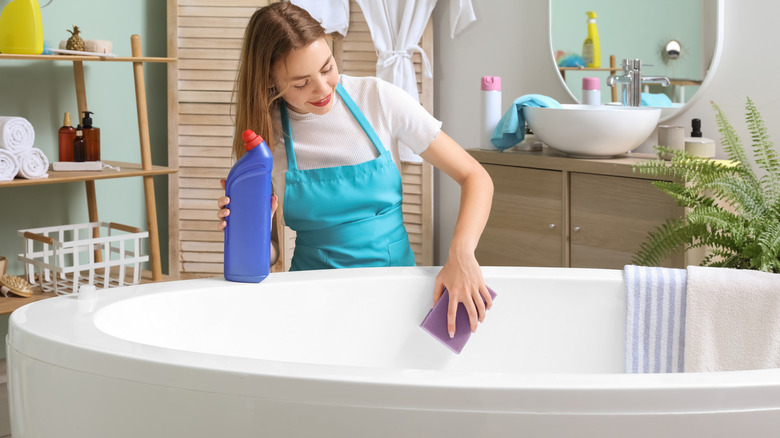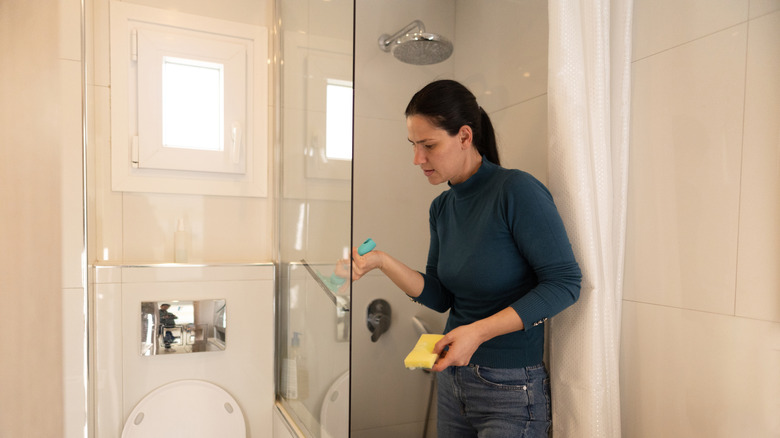Cleaning Your Bathroom Should Always Start In This Spot
A long and warm shower is like a system reset. The water washes away the tiredness of the day and preps you for a good night's sleep. But it does not take long for the relaxing reset to become the reason for stress. When you look at the tiles coated in soap scum and the glass streaked with water stains, the entire experience falls flat.
It may seem like a shock, but the shower and bathtub collect more build-up than you realize. This is why experts say that showers and bathtubs (that appear clean on the face of it) should be cleaned first. After a hot shower, the bathroom is moist and warm and it becomes the perfect breeding ground for bacteria, mold, and mildew. Research by the American Society for Microbiology shows that biofilms (invisible layers of microorganisms) can form on showerheads because they can withstand high water pressure.
Another reason for starting with cleaning the bathtub and shower is the prevention of cross contamination. If you clean the toilet first (which we often do), then you may unknowingly use the same sponge or gloves in the shower area, and risk the transfer of harmful microbes to other areas of the bathroom. And, tackling the shower first means you're cleaning one of the largest and most frequently used surfaces before introducing harsher products elsewhere. Once you start here, you set the stage for a cleaner, safer bathroom overall.
How to clean the shower and bathtub effectively
Start the cleaning process by decluttering the area. Thereafter, your real work begins. Start with a simple mix of vinegar and water or baking soda and water. These household staples break down soap scum without needing to use harsh chemicals. The acetic acid in vinegar dissolves mineral deposits along with hard water, and baking soda acts as a gentle abrasive that lifts residue.
For tough stains or layers of buildup, the two can be combined to form a paste. Spread it evenly from top to bottom and let it sit for several minutes (about 5-10 minutes). This time is very important and allows the acid in vinegar to penetrate and weaken the hold of the scum so you can remove it easily.
Now it's time to work from top down. Scrub tiles and fixtures before rinsing thoroughly. This method reduces the chance of redepositing dirt and ensures that gravity works in your favor. And because you are using eco-friendly cleaners, your bathroom will smell fresh as can be and won't fill the air with strong chemical smells.
Tools and habits to keep the shower clean for longer periods
Once you get the hang of the right tools, you'll realize that shower cleaning won't be a workout anymore, just a quick routine. For most surfaces, you can use a brush with soft bristles and a non-scratch scrub pad. Microfiber works best for most fixtures and attachments in the bathroom and a squeegee for glass doors. Remember to always test a product in an area of the tile or fixture to make sure they don't cause accidental damage.
Drying is as important as scrubbing. Wipe down walls, doors, and fixtures with a clean cloth after you use a solution to remove any leftover moisture and prevent the formation of mold and mildew. Proper ventilation also matters. Leave the exhaust fan on after cleaning or open a window for surfaces to dry faster and any smell to go away.
If you regularly follow all the methods, your bathroom will need fewer deep cleans. In fact, according to some experts, you must clean your bathroom bi-weekly to prevent any form of build-up. This way, you can clean your bathroom and keep it clean.


